This post is also available in: Español
Guatemalan tamales colorados are one of my favorite traditional Guatemalan dishes. After lots of experimenting, I have come up with the best recipe for Guatemalan tamales, including easy step-by-step instructions. This Guatemalan tamal recipe is based on my grandmother’s recipe, with some personal tweaks. Made with corn masa and a chicken or pork filling wrapped in fresh banana leaves, this Guatemalan food differs from the traditional Mexican tamale.
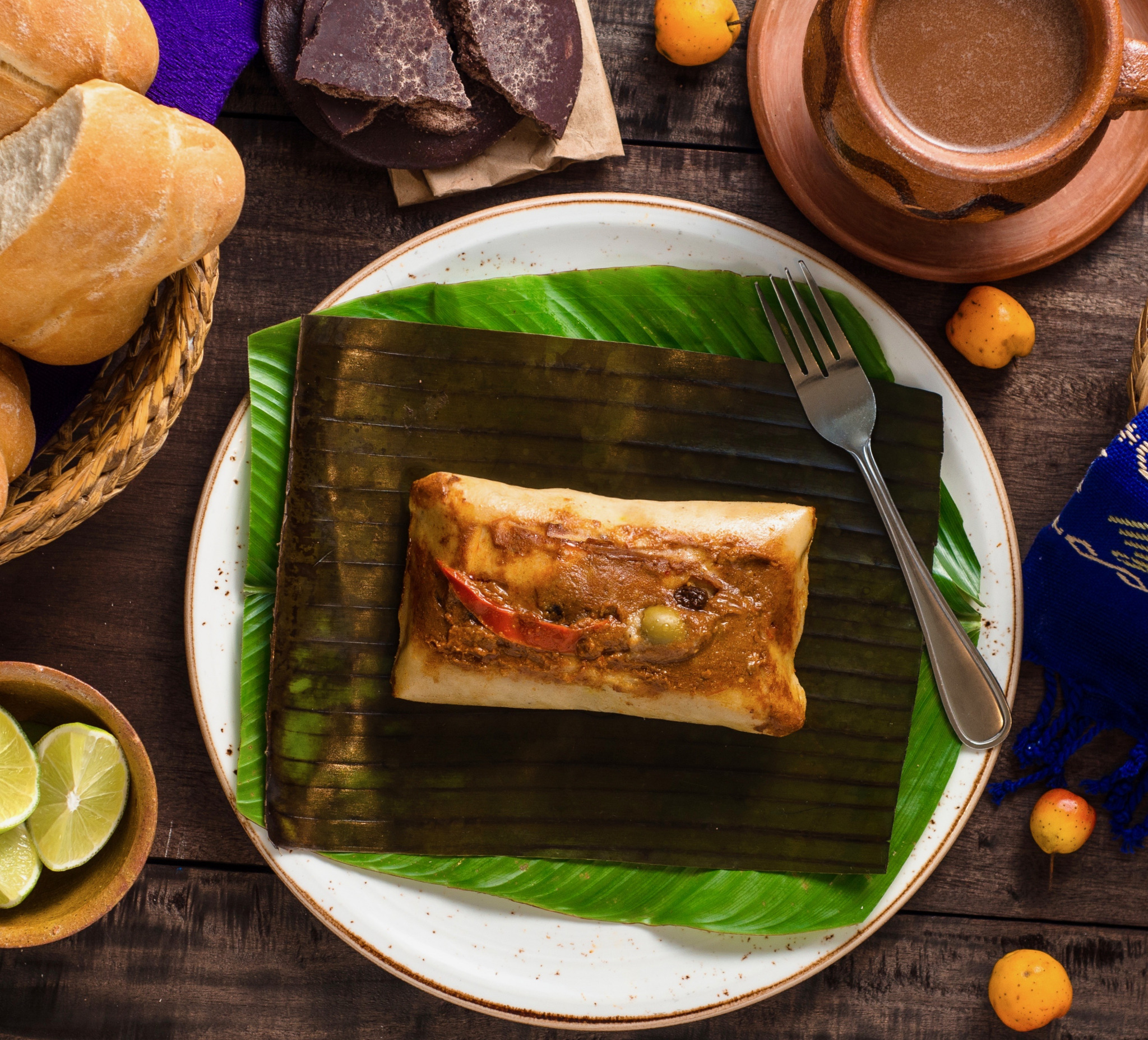
Tamales Colorados is considered by many to be Guatemala’s national dish, usually served on Christmas Eve and other holidays; they are also commonly eaten on Saturdays, which is “tamale day.” Tiendas (or neighborhood stores) will place red lanterns outside to let people know that tamales colorados are available.
But nothing compares to a homemade tamal right out of the pot! Making tamales takes some time, but I have broken down the process into very easy steps to follow. My love for Guatemalan tamales is a vital part of my Hispanic Heritage, one I love sharing with my family.
Making this flavorful Guatemalan dish along with your family is part of the fun. So host a tamalada party at your house and enjoy these delicious Guatemalan tamales not only during holidays but any day. I do hope you enjoy one of my all-time favorite Guatemalan dishes as much as I do!
What is a Guatemalan Tamal Colorado?
The authentic tamale Colorado (red) is a savory tamal made of corn dough, meat, and a rich recado sauce wrapped in large banana leaves. The dough is known as “masa,” made from dried corn, ground into a fine flour, and mixed with water. The filling is usually made from chicken or pork, with a savory recado sauce on top.
This Guatemalan food has a double-cook method: first, you boil the dough until it reaches the desired consistency, then the dough is combined with the meat and sauce, wrapped in banana leaves, and finally steamed until fully cooked. The banana leaf tamale is served at midnight during Christmas Eve dinners and other Guatemalan festivities like New Year.
What are the Ingredients for Guatemalan Tamales?
- Corn-based dough
- Pork or chicken meat
- Tomato-based sauce (also known as recado)
- Green olives and sweet red peppers (as garnish)
The main ingredient for Guatemalan tamales is corn flour mixed with water. The stuffing is usually made from pork or chicken and glazed over with a flavorful tomato-based sauce known as recado. It is then garnished with tasty olives and sweet peppers, wrapped in banana leaves, and finally steamed.

Difference between Mexican Tamal and Guatemalan Tamal
Mexico and Guatemala share many things, from rich cultural history to incredible tropical weather and a geographical border. They also share many similarities when it comes to food. The differences may seem very subtle, but if you ask someone from Guatemala or Mexico, the difference between a Mexican and Guatemalan tamal, tostadas, or taco is huge!
Take, for example, the famous tamales, a traditional meal in both territories. However, you may be more familiar with the Mexican dish, which is usually smaller, uses thicker masa, and has a firmer, drier consistency.
The ingredients for both Guatemalan and Mexican tamales change, depending on the region. Both countries have many different types of tamales, with endless variations: from sweet to spicy, and all in between. Mexican tamales, and Mexican food in general, tend to be spicier using chili purees or dried chili powders in the masa, the filling, or the recado. In contrast, Guatemalan red tamales are usually not that spicy.
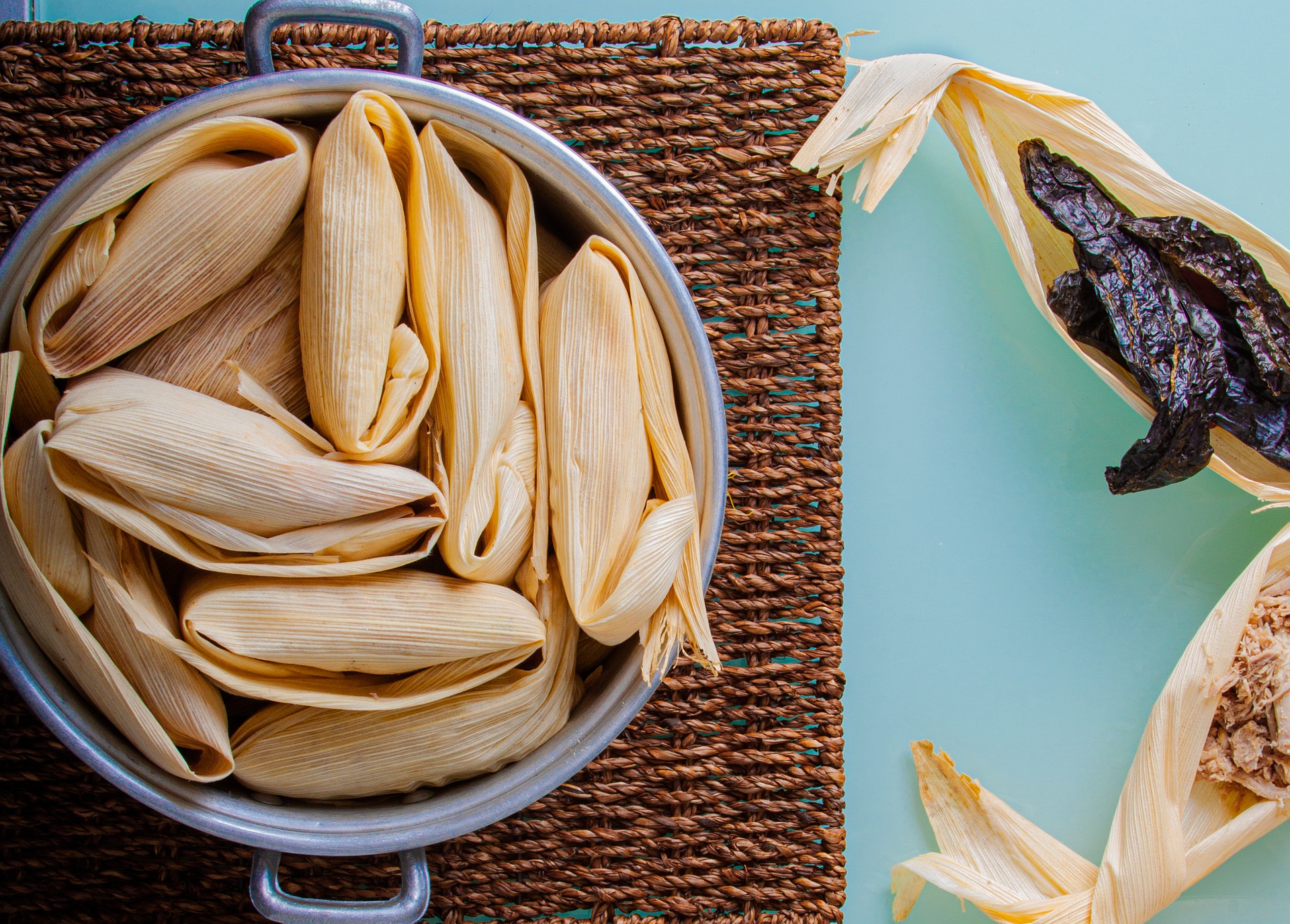
Another difference is the wrapping materials. In Mexico, the dough is wrapped in corn husks, while in Guatemala, the most popular tamales use banana leaves, giving the dish a more floral scent. And the banana leaf version is typically three times larger than the ones made with corn husks. However, some tamales in Guatemala use corn husks, like the smaller chuchito tamales.
There are also differences in the cooking method. The Guatemalan tamal recipe calls for two forms of cooking: first, you boil the dough, then the stuffed wrapping is steamed. The Mexican version is cooked once, hence the thicker consistency. One thing is for sure: You will find countless recipes for this tasty dish across Latin America, some very similar and others entirely different, but all bursting with flavor and a rich ancestral tradition.
Types of Guatemalan Tamales
The word “tamal” comes from the Nahuatl word “tamalli,” meaning wrapped, and by now, you must have guessed there are many variants of the same dish. The differences are in the leaves used for wrapping, the size, ingredients, and even the cooking method.
You can make the “masa” or dough using corn, rice, potatoes, or a combination of these. The stuffing and recado or sauce can vary from savory and spicy to sweeter versions using sugar, nuts, and fruits. Some tamales are wrapped in banana leaves, while others use corn husks. The most common Guatemalan tamales include:
- Tamales Colorados (red): This well-known dish has corn-based dough stuffed with pork or chicken meat and a savory recado (red sauce). It is garnished with green olives and sweet red peppers and then wrapped in banana leaves.
- Tamal Negro (black): Thanks to its sweet Mole-style sauce made from chocolate, it is a darker and sweeter version than its red counterpart. The stuffing is filled with chicken, turkey, or pork meat and garnished with raisins, almonds, and prunes. This banana-leaf-wrapped dish is a tremendous crowd-pleaser during the holiday season.
- Tamalitos de Elote: They use a sweet corn-based dough instead of the typical “masa.” They contain whole kernels of sweet corn and no meat.
- Tamales de masa: The smallest and simplest version is plain in taste, with no filling, cooked in corn husks that give a thicker consistency. They are used in place of bread to dip in soups and salsas rather than eaten alone.
- Tamalitos de Cambray: A sweet tamal made with sweet corn-based dough (no meat added) and usually includes raisins, almonds, and anise. They are prepared for special occasions.
- Chuchito Tamales: They have a thicker corn-based dough filled with chicken and recado sauce similar to the tamales colorado, but wrapped in corn husks instead of banana leaves. Smaller in size, they are a very popular meal, served at celebrations or from street vendors every day of the week.
- Tamales de Chipilín: Similar to the Chuchitos in size and consistency, the tamalitos de chipilin have chipilín leaves added to the mix. Chipilín is a legume with a distinctly earthy, sour flavor that, when cooked, turns mild and pleasant. It tastes a bit like a cross between spinach and watercress.
- Paches: They are made from mashed potatoes instead of corn dough. Everything else is similar to the tamale recipe, including meat and recado stuffing.
How to Make Guatemalan Tamales Colorados:
Yields about 20 tamales
I have broken down the recipe for tamales Colorados with pork filling into sections that include clear step-by-step directions to make the process easier.
You can stuff your tamales colorados with pork or chicken; for this recipe, I used pork. But if you prefer chicken, simply substitute the pork shoulder for chicken. I recommend using dark chicken meat, like thigh, but you can also use chicken breast if you like white meat. Traditionally, chicken tamales in Guatemala use chicken pieces with bones, making it challenging to pick out when eating.
I recommend using boneless chicken. If using chicken, the cooking time for the meat may vary as chicken cooks faster than pork. However, the cooking times for the tamales will be the same.
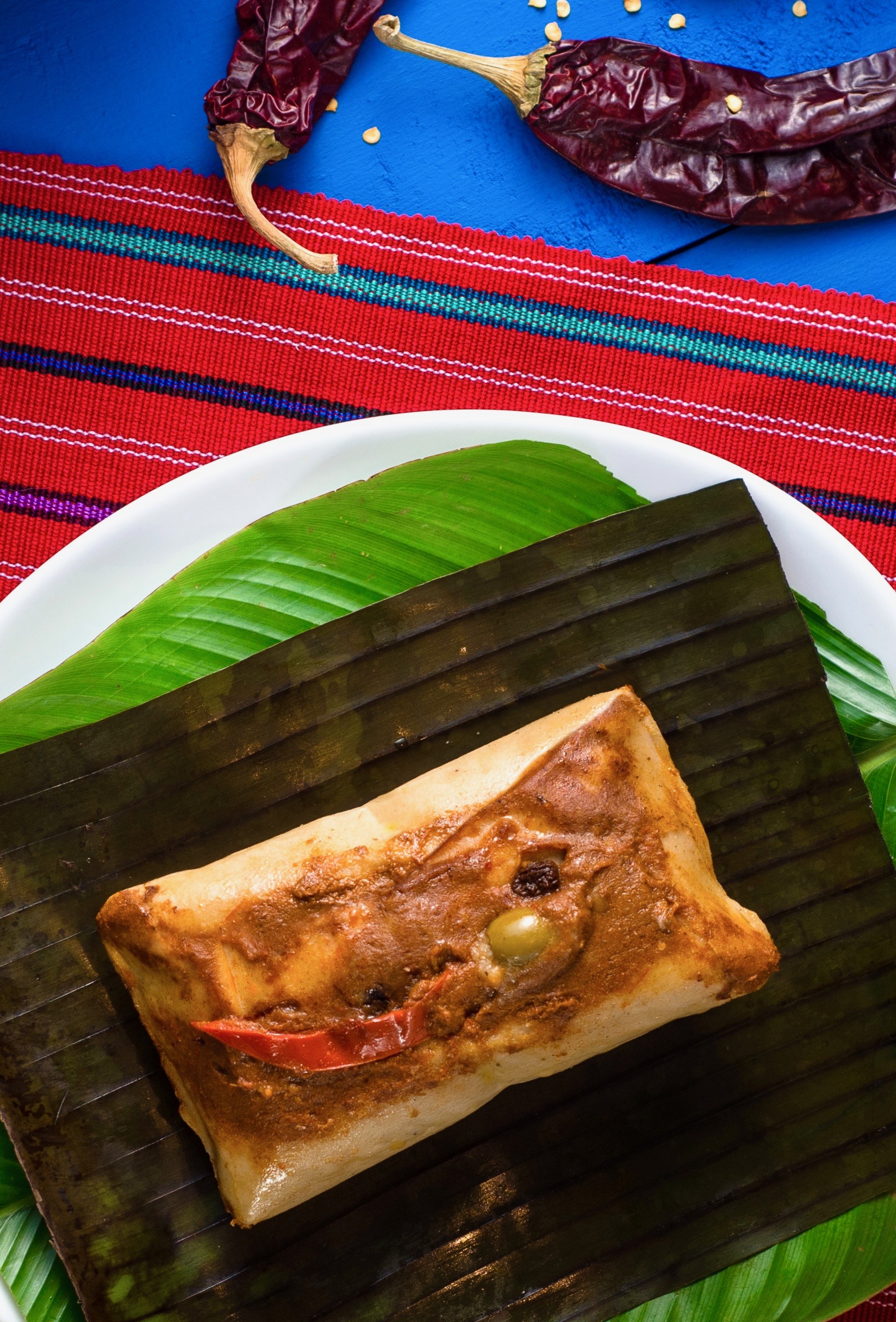
Ingredients for tamales colorados
For the Dough (Masa):
- 2 lbs of instant corn flour (like Maseca)
- 4-6 cups of water
- 1 ½ lb of lard (or 1 stick of butter + 1/2 cup of vegetable oil as a substitute)
- Additional water
- 4 Tbsp of salt
For the Meat Filling:
- 2 lb of boneless pork meat (shoulder) or chicken pieces
- 1 oz of lard
- Salt and pepper to taste
For the Recado (sauce):
- 18 Tomatoes, ripe
- 8 Tomatillos (miltomate)
- 3 Red bell peppers
- 1 Onion
- 2 Garlic cloves
- 2 Guajillo peppers (Chile Guaque) can be found in Mexican grocery stores
- 1 Pasa pepper (Mexican Pasilla Pepper)
- 2 Sambo peppers (or Jalapeño Peppers as a substitute)
- 1 tsp powdered black pepper
- 3 Allspice seeds (Pimienta Gorda)
- 2 oz of lard
For assembly and garnish:
- 40 Banana leaves
- 2 Bunches of cibaque (or kitchen twine/cooking strings for wrapping)
- 2 cooked sweet red peppers (cut into 20 strips)
- 20 Green olives, pitted or stuffed with red pepper
How to Make the Masa (corn dough) for tamales:
- Mix the corn flour with the water, adding half a cup of water at a time until the dough has reached the consistency needed to make a dense ball of masa.
- In a wide bowl, put the dough and dilute it with the additional water, whisking it to prevent lumps from forming until you get a smooth dough.
- Pour the dough into a large pot and cook it, constantly stirring with a wooden spoon to avoid the batter from settling or sticking to the container.
- As it boils, add the lard and salt. Keep cooking it until the dough is well done and not very hard. It should be about the consistency of porridge. Add more water if needed.
- You’ll know it’s ready when the dough starts to peel off from the edges of the pot with ease. Another way to check it is to put a tablespoon of dough in a glass of water. If the dough does not fall apart inside the water, you are good to go.
- Set aside and let it cool down.
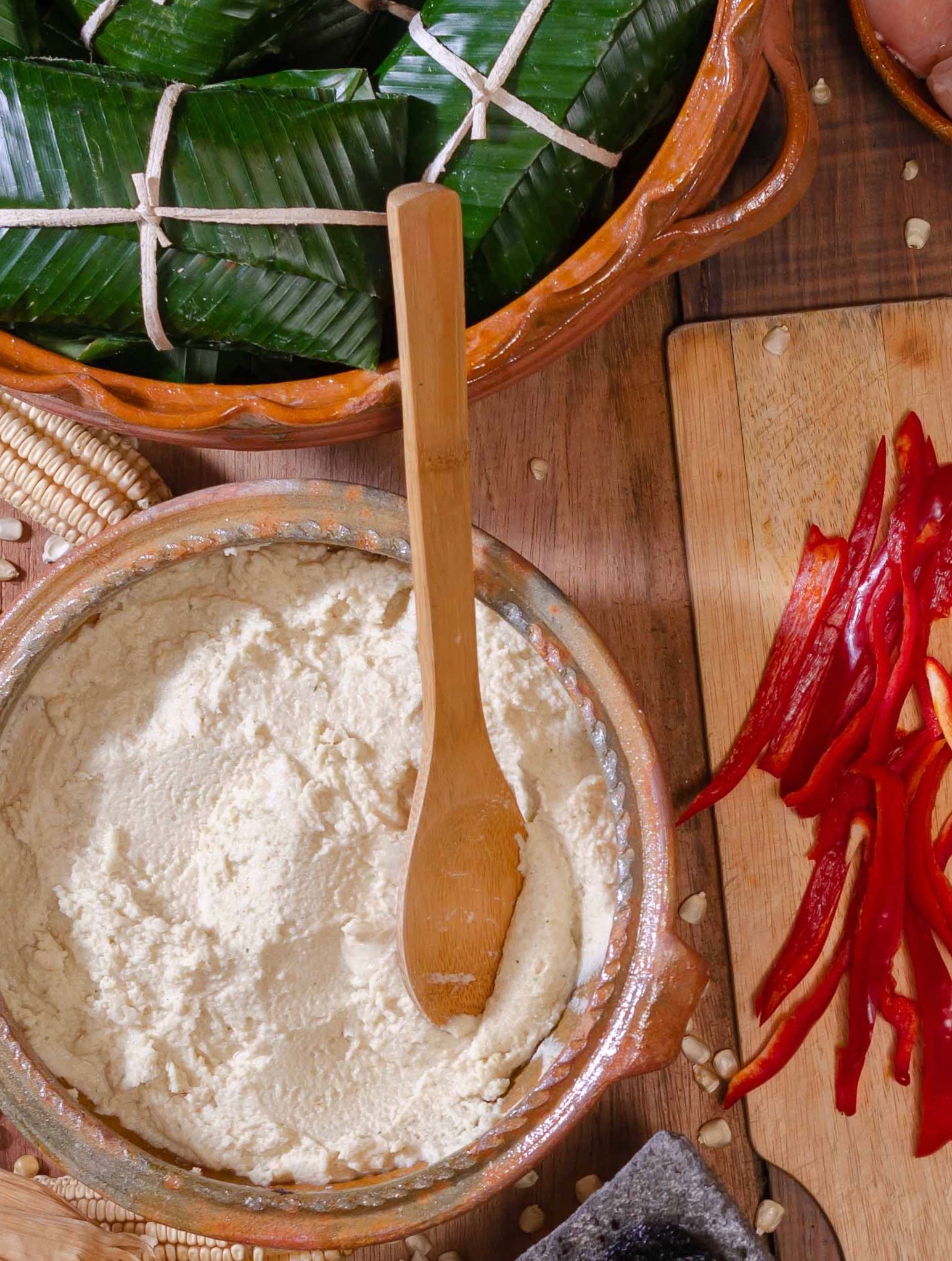
Chicken Filling for Guatemalan tamal:
If you choose to use chicken, you can follow the same instructions as the pork filling using 1-inch pieces of chicken. Traditionally pieces of chicken drumsticks, a piece of thigh, or a part of the chicken breast are used. For this recipe, I used chicken drumsticks. Cook the chicken separately and use the entire cooked drumstick to place into your tamal.
Pork Meat Filling for Guatemalan tamal:
- Cut the pork or chicken into 20 cube-shaped pieces and rub them with salt.
- Cook the meat cubes in a large pan with oil or cooking spray until cooked through, about 8-12 minutes.
- Set it aside to keep warm.
How to Make the Recado (sauce) for Guatemalan tamales:
- In a large pot, pour enough water to cover the tomatoes, tomatillos (miltomates), red peppers, onion, garlic, and the Guajillo, Pasa (Pasilla), and Sambo (Jalapeño) peppers. Bring to a boil until they are soft and the peel starts coming off.
- Peel the tomatoes so as not to have any coarse flakes. Add the black pepper and allspice and put everything in a blender. Blend until smooth (it should look like a thin sauce).
- Return the tomato sauce to the same pan where the meat is, adding 2 ounces of lard, and check the seasoning.
- If the sauce is very watery, you can thicken it using two tablespoons of corn flour. Cook it until you get a sauce with a thick consistency to prevent it from leaking when preparing the wrap.
- Set aside for assembly.

How to Assemble Homemade Tamales:
- Slice the thickest part of the vein for the first 20 banana leaves (lengthwise, about halfway towards the trunk). Cut the other 20 leaves in a rectangular shape, about 12×8 inches.
- Toss all the leaves in boiling water, cleaning them thoroughly. Use tongs to help get them completely immersed in the water. Stack on a plate and cover with a damp cloth.
- Soak the cibaque, or string in water and cut it in half when it is already wet (to make it yield).
- Gather all the dough, fillings, and garnishes, and set them up on your kitchen counter or a worktable to start assembling.
- Place a large banana leaf on the counter and then a smaller cut leaf on top (crosswise). With a soup ladle, scoop about 5-6 oz of dough and place it in the center of the leaf. Then press the center of the dough with three fingers to make a small hole.
- Put a piece of meat in the hole and add 1 to 2 tablespoons of recado. Place one olive and one strip of sweet pepper on top.
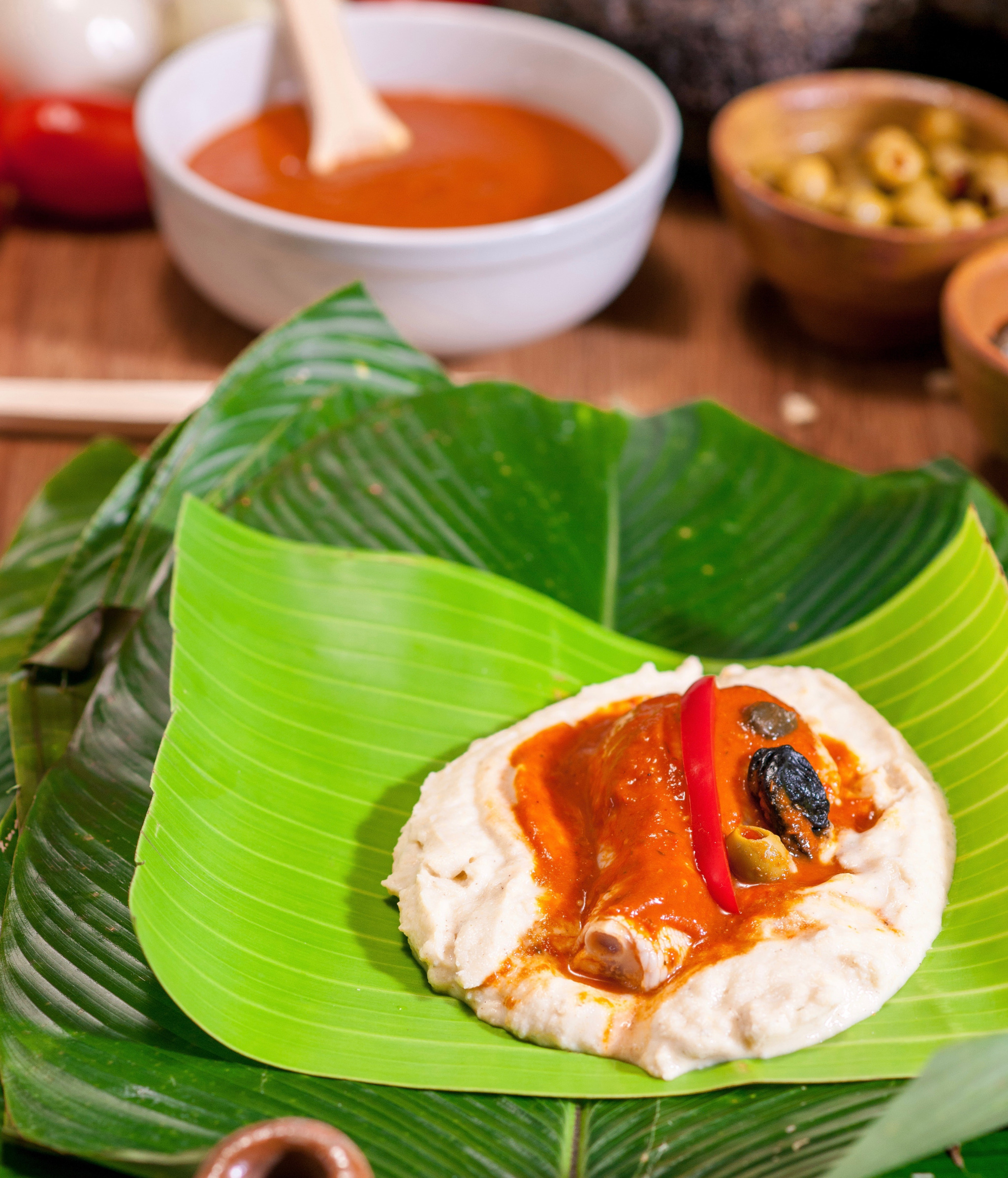
How to Fold Banana Leaf Tamales:
- Fold the banana leaf side closest to you over the dough and bring the side farthest from you towards yourself. You will end up with a long, skinny rectangle.
- Carefully wrap the dough by folding one long end under and the other long end over it.
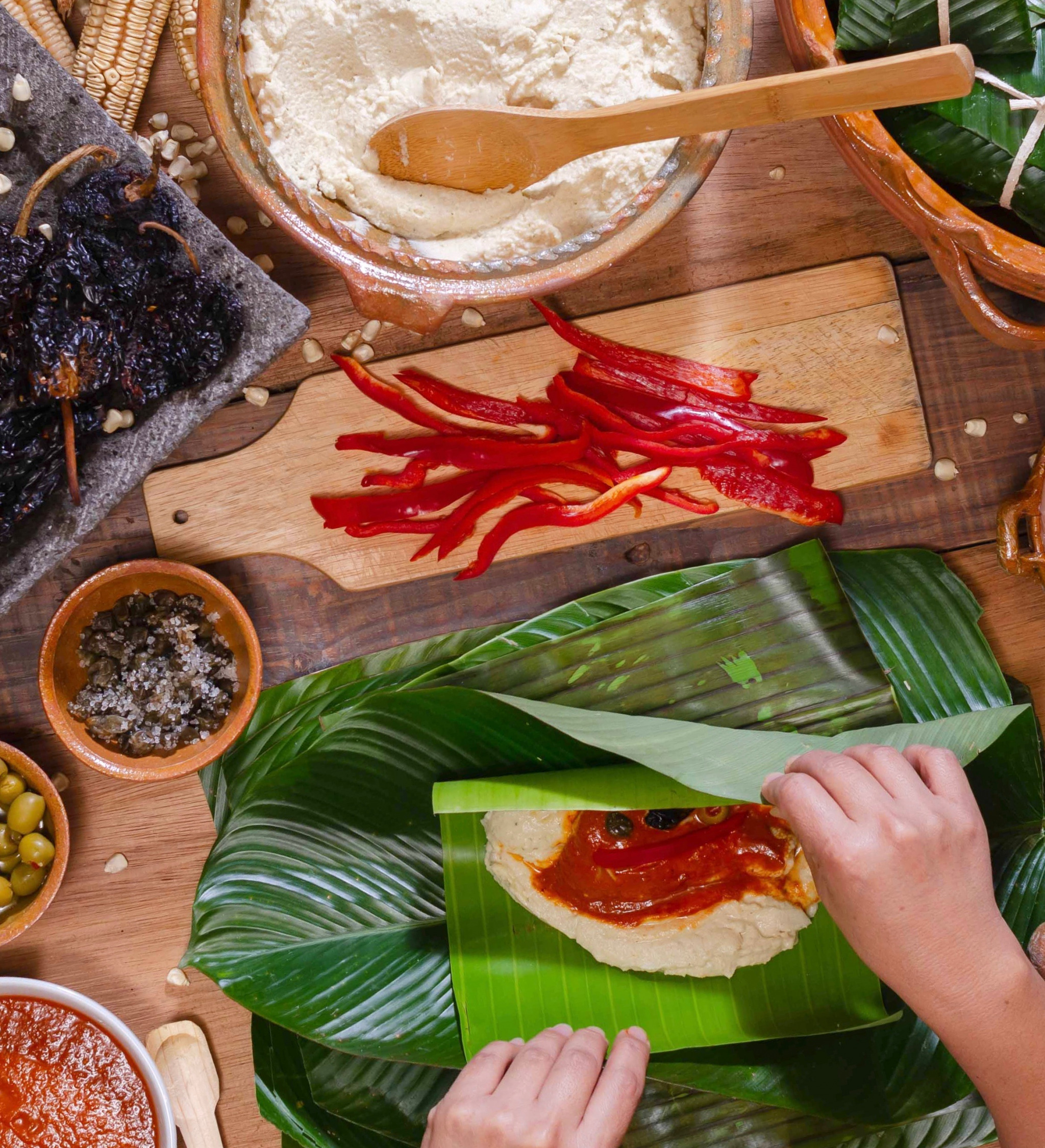
- Use the string to tie up the wrap, making sure it is tight enough.
- Repeat until you go through all the dough and leaves.
- I like to wrap my tamales with an extra layer of aluminum foil on top of the banana leaves. This extra layer makes it easier to store the tamales once cooked, whether you’re refrigerating them for a few days or freezing them.
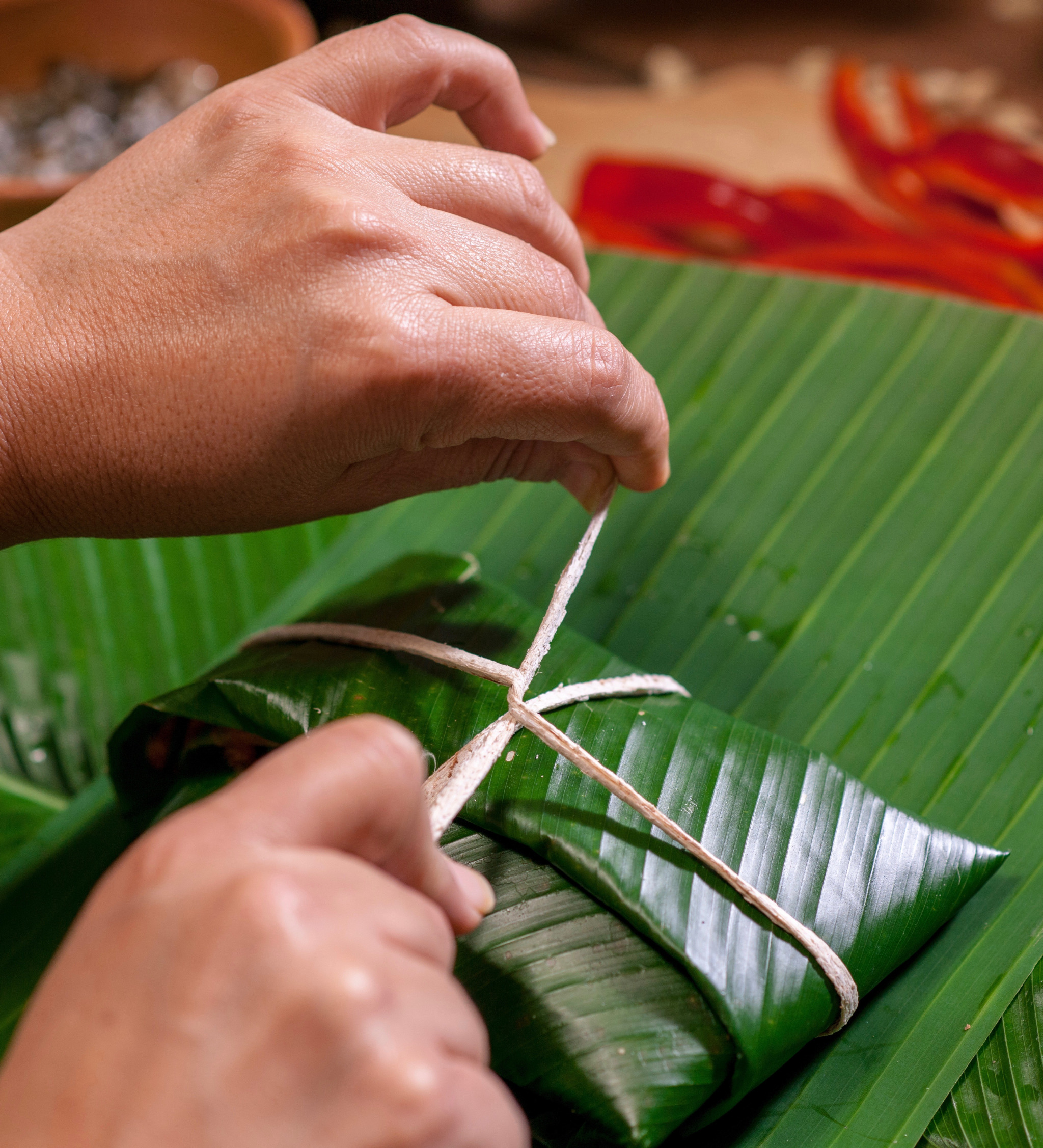
How to Cook Tamales
- To cook, place a steam basket on the bottom of a large pot. Add about 2-4 cups of water (depending on the size of your container). Line the basket with some extra pieces of banana leaves.
- Place the wraps in the basket, making sure they don’t touch the water. Cover them with remaining leaves. Cover the container and bring it to a boil. Add more boiling water if necessary.
- Steam over medium heat for 60-90 minutes until the dough easily separates from the leaf and is slightly firm (they will continue to harden after being removed from the heat).
- Unwrap the tamales and serve them hot or at room temperature.
Make Ahead of Time
This traditional Guatemalan recipe is one of my all-time favorites but a time-consuming one. I recommend you make a strategy, as it will take you a couple of hours to finish the entire meal. You can cook everything the same day or take a few shortcuts, like cooking the recado sauce ahead of time.
While you are at it, why not make a double batch and save the leftover recado for another Guatemalan dish? This sauce is extremely flexible! You will use it on loads of different foods, like a delicious Huevos Rancheros Avocado Toast.
If you choose chicken as your main ingredient for the stuffing, cook it the day before and keep it in your fridge. However, if you decide on pork, I suggest doing it the same day, as the meat tends to dry up when refrigerated.
As for the dough, it is best to make it the same day, so it doesn’t dry out and becomes too stiff. But cooking everything else a couple of days before is a great idea, freeing up some time to do the assembly and final steaming.
Tips for making Tamales Guatemaltecos:
- Butter Makes Everything Better: You can change the lard on the dough for a stick of unsalted butter. It is a great idea to melt it beforehand to mix effortlessly with the dough and avoid forming lumps.
- Be a Recado Expert: For a smoother recado, it is best to peel the tomatoes after boiling them to get a smoother sauce. Don’t push the sauce through a strainer, as it could lose some of its tangy flavors and body. Better use a blender and work it a little longer for a more delicate sauce.
- Substitutes for banana leaves: You can always use aluminum foil to wrap if you can’t find banana leaves. You may not get the grassy flavor from the leaves, but it works.
- Use a wooden spoon: Wooden spoons are a strong tool that helps you scrape things off the sides and bottom of your pot while mixing the corn dough. In addition, they give you a firm handle on things, making stirring easier and more effective.
What is the Best Way to Freeze Tamales?
You might be wondering, do I freeze them cooked or uncooked? In my experience, it is best to freeze the tamale wrap already cooked because they can retain their consistency and flavors better than uncooked ones. You can keep them in the fridge for a few days or freeze them for up to 6 months. Besides, it makes the reheating process a little easier.
If you decide to embark on this culinary adventure with me, you will not make just one, right? This recipe yields 20 portions, and if you are not planning a big family gathering, you will indeed have some leftovers for when you crave a traditional Guatemalan meal. Here are some tips on the correct way to freeze them:
- After steaming, remove the tamales from heat and place them on a flat surface. Let them cool down at room temperature before freezing.
- Place the tamales in a freezer bag, gently stacking them on top of another to provide an extra layer of protection against other frozen items and prevent condensation from leaking into the dough.
- Don’t forget to label the bag so you know how long they have been sitting in your freezer.
How to Reheat Tamales
To reheat tamales, follow these simple steps:
- If they are frozen, you will need to thaw the tamales first. To thaw, place them in your refrigerator and let them defrost overnight. Don’t leave any food at room temperature: it is a bacteria magnet!
- When it is time to reheat, simply set a pot with a steamer basket and add an inch or two of water, careful not to get the tamales wet. Cover the pot with a lid and place it over medium heat for 10-15 minutes.
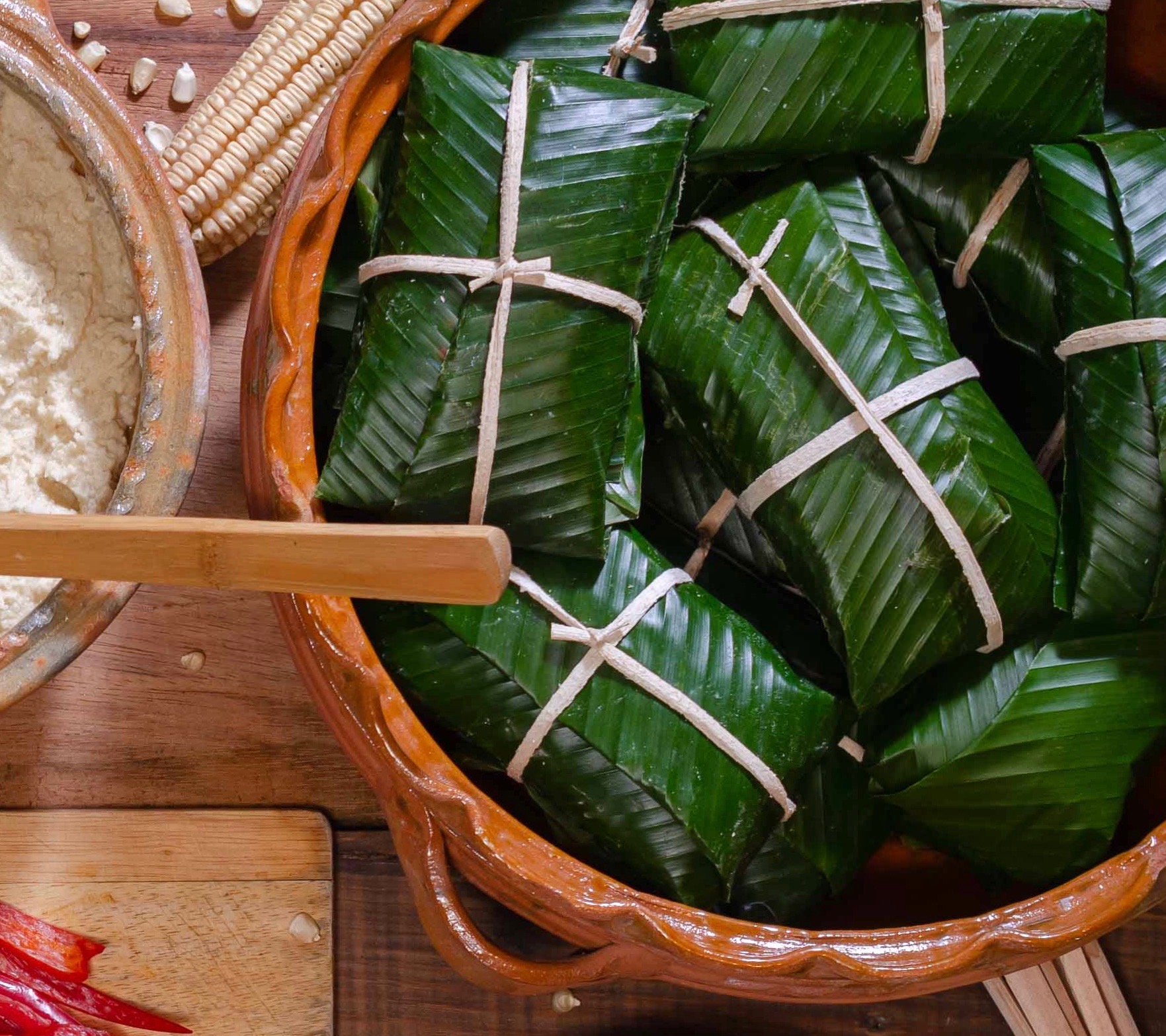
How to Reheat Frozen Tamales
You can also reheat the tamales right out of the freezer without thawing. It is the same process as reheating thawed dough; the difference will be in the cooking time: 20–30 minutes. Before you take the whole batch off the stove, open one wrap to check if it is fully defrosted and hot enough to eat! To learn how to reheat tamales the best way (and other alternative options), click here.
What To Serve with Traditional Guatemalan Tamales?
Traditionally, Guatemalan tamales are served alone on a plate with a squeeze of lime and a slice of traditional pan Francés, a traditional Guatemalan bread. It’s also common to eat this Guatemalan dish with black beans and white rice. Platanitos fritos (fried plantains) is also a great side dish that makes a delicious contrast in flavors between salty and sweet. For the holiday season and Christmas Eve, tamales colorados are usually accompanied by a warm cup of chocolate caliente, Guatemalan hot chocolate.
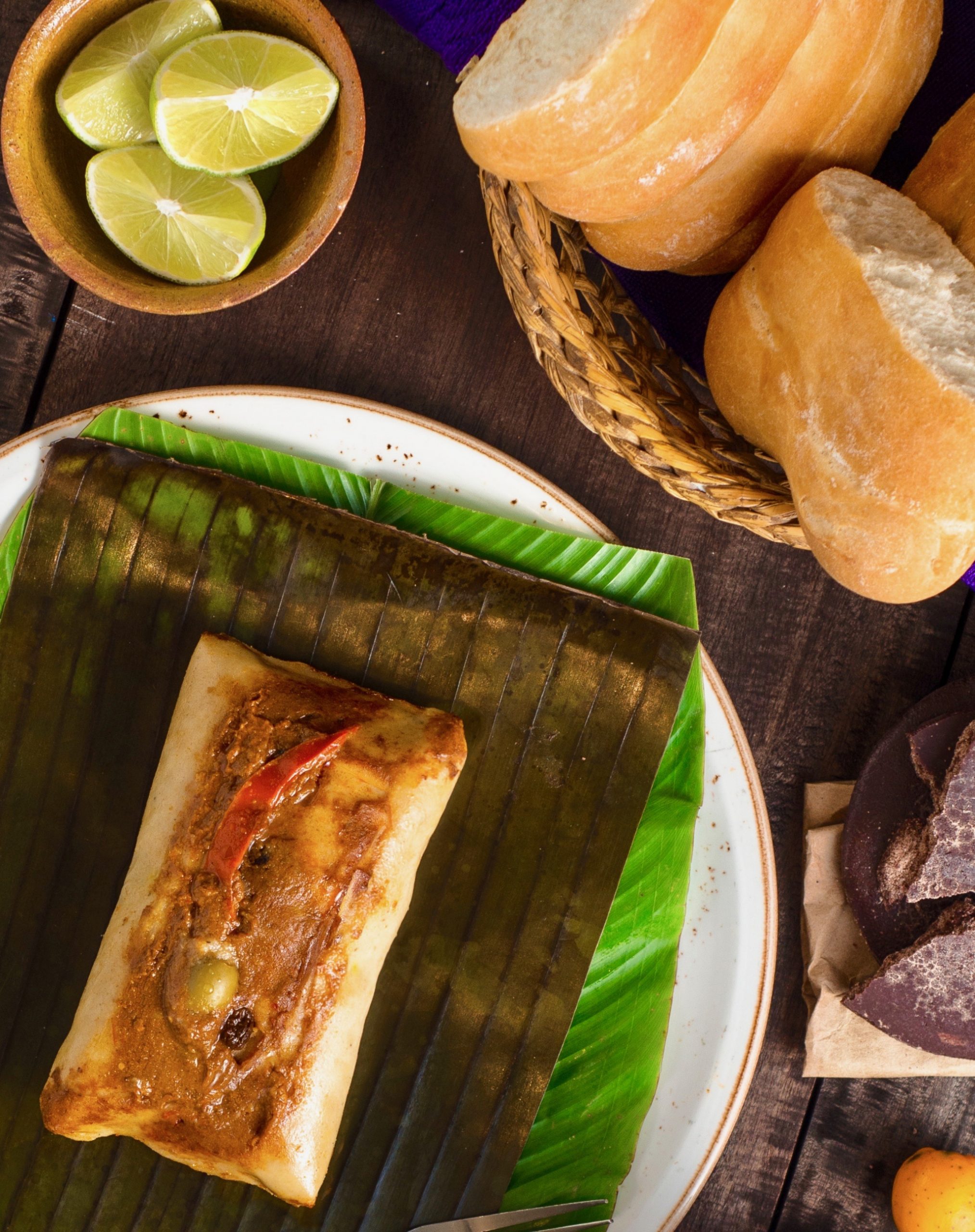
Feel free to accompany your tamales with some non-traditional side dishes like fresh avocado and cucumber salad. One unspoken rule about Guatemalan tamale eating etiquette: You can eat as many as you want, but you can only have one on your plate at a time.
Other Traditional Guatemalan Recipes
- Traditional Guatemalan Enchiladas or Jardineras: A traditional Guatemalan dish, it is a fairly easy Guatemalan recipe. Made with a toasted tortilla topped with a vegetable mixture or escabeche, ground beef, and tomato sauce, it is one of my favorite authentic Guatemalan foods.
- Guatemalan Tapado Recipe: A taste of the Caribbean and Garifuna flavor, Guatemala’s Tapado seafood soup is a legacy of history and an explosion of flavor. It’s the brilliant and harmonious mixture of luscious seafood cooked in savory coconut broth.
- Guatemalan Chiles Rellenos Recipe: This traditional Guatemalan recipe is somewhat different from the Mexican Chiles Rellenos. It is sweet peppers filled with a concoction of beef and veggies, and a drizzle of tomato sauce.
- Pollo En Jocón (Tomatillo Chicken Stew): This easy and healthy recipe for Pollo en Jocón, tomatillo and cilantro chicken stew, is a traditional dish from Guatemala. Delicious and easy to make, it’s the perfect cold-weather comfort food.
- Guatemalan Rellenitos: Rellenitos are made with ripe plantains, filled with beans, and covered in sugar. Although the combination might seem strange, this sweet plantain recipe is one of the most delicious Guatemalan foods.
- Guatemalan Buñuelos: Buñuelos are fried wheat-based dough balls, crisp on the outside and soft on the inside, covered in white sugar, and served in a light syrup with a hint of anise.
Nothing says traditional Guatemalan foods better than a savory tamal colorado! And even though I know this Guatemalan dish is fairly labor and time-consuming, it is one of the best recipes for Guatemalan tamales I have ever tried. I suggest you plan to spend half a day making them, but I promise you won’t regret all the extra effort.
Here’s an idea: Why not invite the whole family and make it a tamalada party? It could be the beginning of a beautiful family tradition!
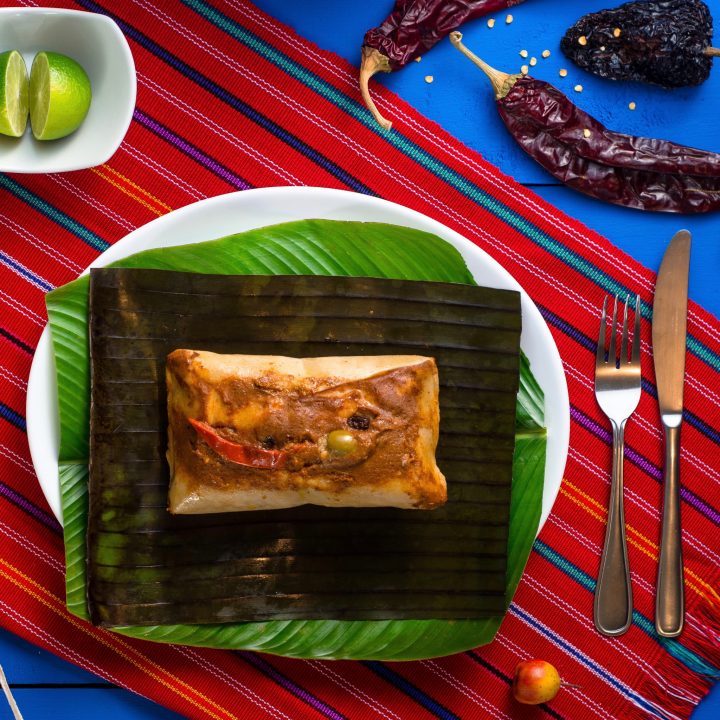
The Best Recipe for Guatemalan Tamales Colorados
Guatemalan tamales colorados are one of my favorite traditional Guatemalan dishes. After lots of experimenting, I have come up with the best recipe for Guatemalan tamales including easy step-by-step instructions.
Ingredients
For the Dough (Masa)
- 2 lbs of instant corn flour (like Maseca)
- 4-6 cups of water
- 1 ½ lb of lard (or 1 stick of butter + 1/2 cup of vegetable oil as a substitute)
- Additional water
- 4 Tbsp of salt
For the Meat Filling
- 2 lb of boneless pork meat (shoulder) or chicken pieces
- 1 tsp of oil or cooking spray
- Salt and pepper to taste
For the Recado Sauce
- 18 Tomatoes, ripe
- 8 Tomatillos (miltomate)
- 3 Red bell peppers
- 1 Onion
- 2 Garlic cloves
- 2 Guajillo pepper (Chile Guaque) can be found in Mexican grocery stores
- 1 Pasa pepper (Mexican Pasilla Pepper)
- 2 Sambo peppers (or Jalapeño Peppers as a substitute)
- 1 tsp powdered black pepper
- 3 Allspice seeds (Pimienta Gorda)
- 2 oz of lard
For Assembly and Garnish
- 40 Banana leaves
- 2 Bunches of cibaque (or kitchen twine/cooking strings for wrapping)
- 2 cooked sweet red peppers (cut into 20 strips)
- 20 Green olives, pitted or stuffed with red pepper
Instructions
TO MAKE THE MASA
- Mix the corn flour with the water, adding half a cup of water at a time until the dough has reached the consistency needed to make a dense ball of masa.
- In a wide bowl, put the dough and dilute it with the additional water, whisking it to prevent lumps from forming until you get a smooth dough.
- Pour the dough into a large pot and cook it, constantly stirring with a wooden spoon to avoid the batter from settling or sticking to the container.
- As it boils, add the lard and salt. Keep cooking it until the dough is well done and not very hard. It should be about the consistency of porridge. Add more water if needed.
- You’ll know it’s ready when the dough starts to peel off from the edges of the pot with ease. Another way to check it is to put a tablespoon of dough in a glass of water: if the dough does not fall apart inside the water, you are good to go.
- Set aside and let it cool down.
TO MAKE THE FILLING:
- Cut the pork or the chicken into 20 cube-shaped pieces and rub them with salt.
- Cook the meat in a large pan using lard or substituting for olive oil or cooking spray.
- Set it aside to keep warm.
TO MAKE THE SAUCE:
- In a large pot, pour enough water to cover the tomatoes, tomatillos (miltomates), red peppers, onion, garlic, and guajillo, pasa (pasilla), and sambo (jalapeño) peppers. Bring to a boil until they are soft and the peel starts coming off.
- Peel the tomatoes so as not to have any coarse flakes. Add the black pepper and allspice and put everything in a blender. Blend until smooth (it should look like a thin sauce).
- Return the tomato sauce to the same pan where the meat is, add 2 ounces of lard, and check the seasoning.
- If the sauce is very watery, you can thicken it using two tablespoons of corn flour. Cook it until you get a sauce with a thick consistency to prevent it from leaking when preparing the wrap.
- Set aside for assembly.
TO ASSEMBLE THE TAMALES:
- Slice the thickest part of the vein for the first 20 banana leaves (lengthwise, about halfway towards the trunk). Cut the other 20 leaves in a rectangular shape, about 12×8 inches.
- Toss all the leaves in boiling water, cleaning them thoroughly. Use tongs to help get them completely immersed in the water. Stack on a plate and cover with a damp cloth.
- Soak the cibaque, or string in water and cut it in half when it is already wet (to make it yield).
- Gather all the dough, fillings, and garnishes, and set them up on your kitchen counter or a worktable to start assembling.
- Place a large banana leaf on the counter and then a smaller cut leaf on top (crosswise). With a soup ladle, scoop about 5-6 oz of dough and place it in the center of the leaf. Then press the center of the dough with three fingers to make a small hole.
- Put a piece of meat in the hole and add 1 to 2 tablespoons of recado. Place one olive and one strip of sweet pepper on top.
FOLDING THE TAMALES:
- Fold the banana leaf side closest to you over the dough and bring the side farthest from you towards yourself. You will end up with a long, skinny rectangle.
- Carefully wrap the dough by folding one long end under and the other long end over it.
- Use the string to tie up the wrap, making sure it is tight enough.
- Repeat until you go through all the dough and leaves.
- I like to wrap my tamales with an extra layer of aluminum foil on top of the banana leaves. This extra layer makes it easier to store the tamales once cooked, whether you’re refrigerating them for a few days or freezing them.
COOKING THE TAMALES
- To cook, place a steam basket on the bottom of a large pot. Add about 2-4 cups of water (depending on the size of your container). Line the basket with some extra pieces of banana leaves.
- Place the wraps in the basket, making sure they don’t touch the water. Cover them with remaining leaves. Cover the container and bring it to a boil. Add more boiling water if necessary.
- Steam over medium heat for 60-90 minutes until the dough easily separates from the leaf and is slightly firm (they will continue to harden after being removed from the heat).
- Unwrap the tamales and serve them hot or at room temperature.
Nutrition Information:
Yield: 20 Serving Size: 1 portionAmount Per Serving: Calories: 363
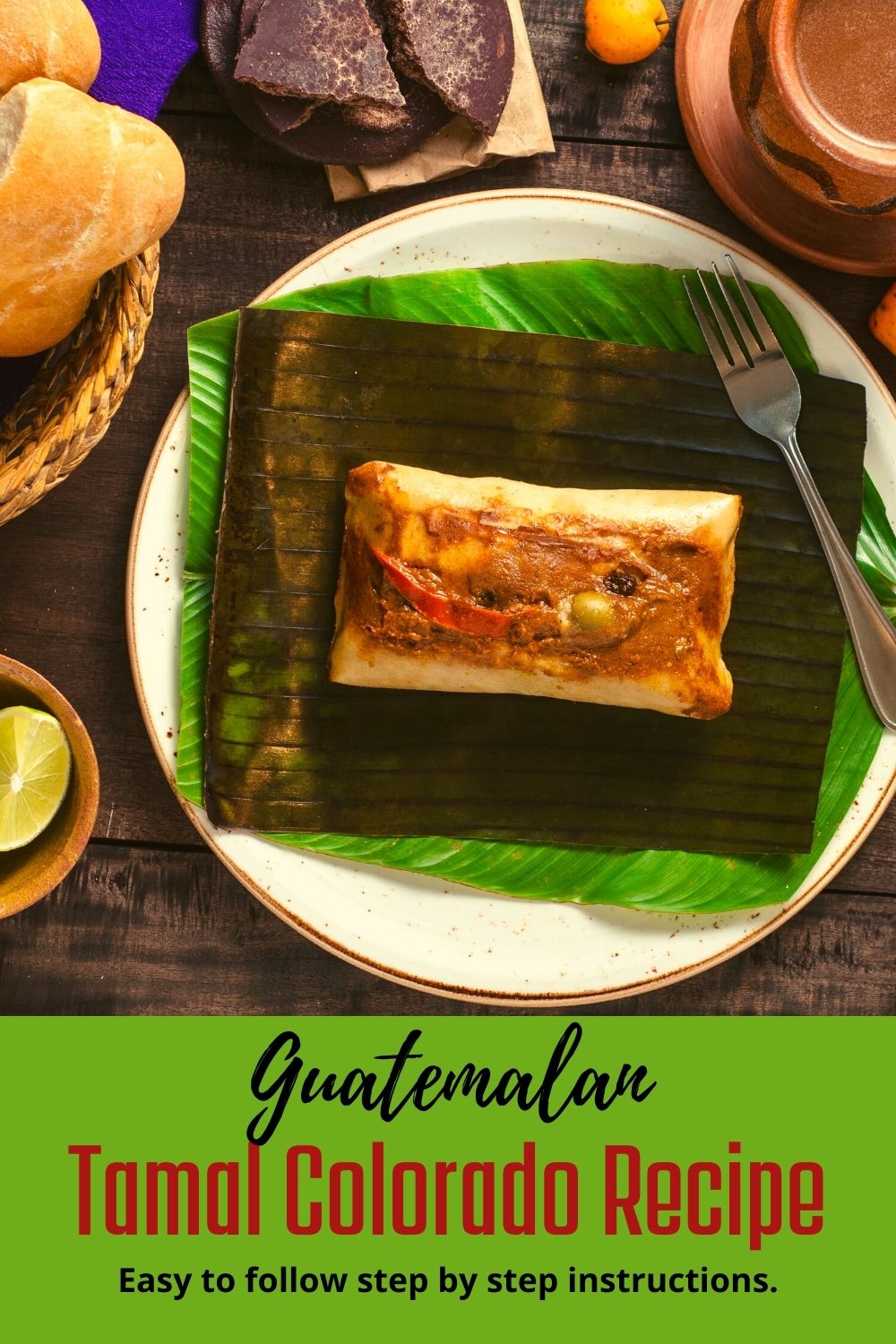

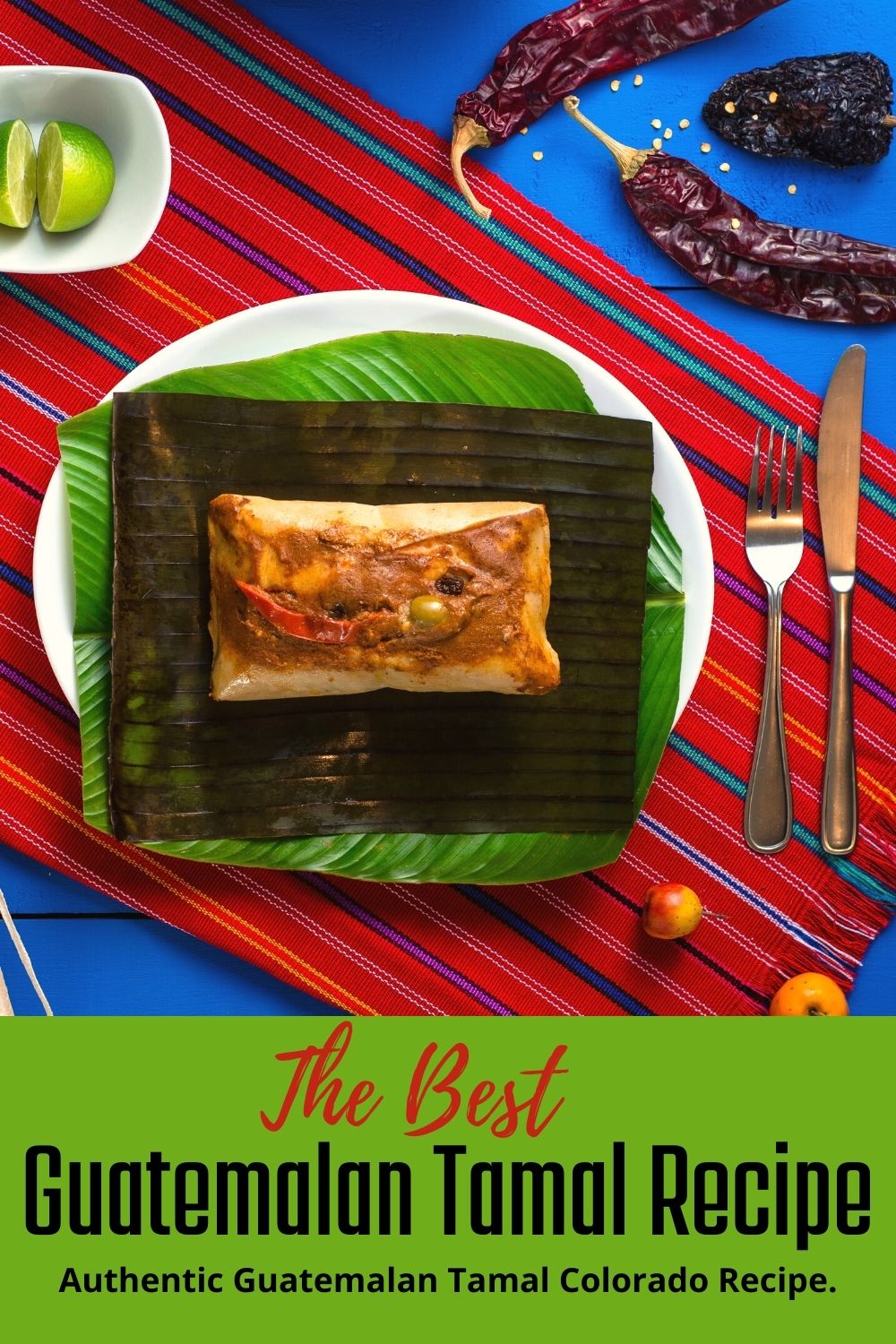




Thanks for sharing the recipe!!! i will try it for chrismas and make a party out of it!!!
Hi Paula, I make Guatemalan tamales every year for my Guatemalan husband. A few things seem to be missing from your recipe, mainly in the sauce. And maybe the areas the recipe came from are why, but he grew up extremely poor and his family’s tamales only consisted of masa, meat, and recado. But consomé is added to the masa and sauce, and pumpkin seeds and sesame seeds are also toasted and added to the sauce, along with toasted pan franceś. I’ve also seen some recipes that call for toasted cinnamon and cloves. He doesn’t like those (not what his mom ever used) but her instructions were for the sauce, tomatos,onion,garlic,pumpkin and sesame seeds,pan franceś, saborine(accent seasoning here in Illinois),consomé, salt and pepper to taste all toasted and ground and cooked down with a little lard. And you are not wrong about the bone thing, he likes pork neck bones in his, and his sister in law tried to feed me one with a chicken foot in it!
Hi Paula! The tamal recipes do change a lot from region to region and even from family to family. Every family has their own recipe but some of the things you mention sound like good additions. I will try adding consome to the masa and adding the toasted pumpkin and sesame seeds to the sauce.
Thanks for sharing the recipe! i love that you can follow easy steps! my favorite Guatemalan food for Christmas!
Hey there!
I just stumbled upon your article about the best recipe for Guatemalan Tamales Colorados, and as someone who loves to experiment with different cuisines, I couldn’t resist reading it. Firstly, let me say that your writing style is fantastic, and it made me feel like I was right there with you in Guatemala, learning how to make this traditional dish.
I particularly loved how you included step-by-step instructions with accompanying pictures, making it easier for even someone like me, who is not an expert in the kitchen, to follow along. The combination of spices and ingredients used in the recipe sounds absolutely delicious, and I can’t wait to try it out myself.
Additionally, I appreciated how you shared the history and cultural significance behind the dish. It’s always fascinating to learn about the traditions and customs of different countries, and your article provided a great insight into the Guatemalan culture. Overall, I thoroughly enjoyed reading your article and I look forward to trying out this recipe and impressing my friends with my newfound cooking skills! Thanks for sharing this valuable information with us.